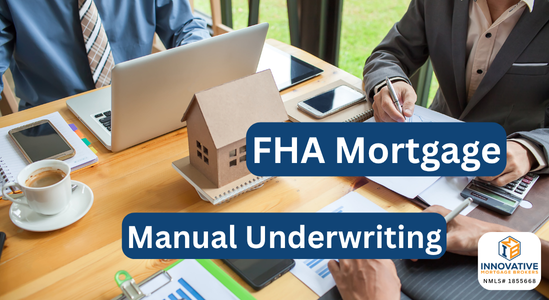Turning Rent into Equity Rent-to-own can work, but only when the paperwork is airtight. Lenders…
FHA Manual Underwriting, Made Simple
Winning an FHA manual underwrite
Buying or refinancing with FHA and just heard “manual underwriting”? Don’t panic, this isn’t a denial, it’s a slower, hands-on review to make sure your loan still works. Lenders use manual underwriting when an automated system can’t see the full picture (think thin credit, past hiccups like late payments, a recent job change, or unique income). A human underwriter will look closely at your budget, payment history, savings, and “compensating factors” like extra reserves or stable rent history.
In this article, you’ll learn what triggers manual underwriting, the debt-to-income ratios to expect, how much in reserves helps, why on-time housing payments matter, and simple ways to strengthen your file, like documenting non-traditional credit and planning for residual income. You’ll also get a step-by-step prep list so you know exactly what to gather and how to keep your closing on track.
What Is Manual Underwriting?
Most FHA loans are first reviewed by software. If your situation doesn’t fit the software perfectly, or the lender wants a closer look, an underwriter reviews your file by hand. That’s manual underwriting. It’s not a denial; it just means a human will verify more details to make sure the loan makes sense.
Common Reasons You Might Be Routed to Manual
- Limited or no credit score (using rent, utilities, phone, etc.).
- Recent credit events (late payments, short sale/foreclosure/bankruptcy inside lookback windows).
- Self‑employed income that changed a lot year‑to‑year.
- Disputed derogatory accounts on your credit report.
- Unique situations the automated system can’t read (ID mismatches, prior mortgage history updates, etc.).
What a Manual Review Looks At
- Housing history: on‑time rent or mortgage payments help a lot.
- Debt‑to‑income (DTI): your monthly debts and new payment relative to income.
- Cash reserves: how many months of payment you could cover after closing.
- Overall story: stability of income, savings habits, and responsible credit use.
Buying or Refinancing? What to Expect
- Extra documentation: a few more bank statements, pay stubs, letters of explanation, and proof of on‑time rent may be requested.
- Reserves: FHA often wants at least 1 month of the new payment (PITIA) for 1–2 units, and 3 months for 3–4 units.
- Reasonable ratios: many approved manual files land around 31/43 DTI, but higher ratios can be allowed with strong positives like solid reserves, minimal payment shock, or documented extra (not used) income.
- Timing: plan for a few extra days for underwriting and verification. A clean, organized file still moves fast.
How to Strengthen Your Approval
- Show 12 months of on‑time housing (rent receipts, landlord letter, or canceled checks).
- Build a small cushion: even 1–3 months of payment in savings helps.
- Hold off on new credit and keep balances low while you apply.
- Explain the story behind any late payments or credit events, brief and factual.
- Price the payment: if buying, target homes that keep your budget comfortable.
Little or No Credit Score?
That’s okay. You can document a non‑traditional credit profile with items like rent, utilities, phone, internet, and insurance. Provide 12‑month histories where possible.
Tips for Buyers
- Low down payment: FHA allows as little as 3.5% down; gifts or assistance can reduce cash needed.
- Seller help: sellers can contribute to closing costs within FHA rules.
- Appraisal: the FHA appraisal checks value and basic safety. Plan for normal repairs if needed.
Tips for Homeowners (Refi)
- Rate/Term: lower payment, move from ARM to fixed, or remove a co‑borrower.
- FHA Streamline: if you already have FHA, a streamline may skip income docs and appraisal—manual review can still apply based on history.
- Cash‑Out: tap equity for improvements or debt consolidation; expect full income and appraisal review.
What We’ll Need From You
- Photo ID (and Social Security card if applicable).
- 30 days of pay stubs and last 2 years of W‑2s/1099s (self‑employed: 2 years of tax returns).
- 2 months of bank statements (all pages).
- Proof of rent or mortgage history for 12 months.
- Short letters of explanation for any unique items.
FAQ
Is manual underwriting bad? No. It just means a human will verify more of your story. Many borrowers are approved this way.
Will my payment be higher? Not because it’s manual. Your rate and payment depend on market pricing and your file, not the review method.
How fast can I close? With documents ready, most purchases and refis close on a normal timeline, manual review can just add a few days.
Ready to Get Pre‑Approved?
Start your FHA pre‑approval and we’ll help you organize your documents, frame your strengths for the underwriter, and keep you updated so there are no surprises at closing.
We’re a borrower-first mortgage team with deep FHA manual-underwriting experience. If your loan needs a hands-on review, we’ll translate the guidelines into plain English, map out your qualifying path (ratios, reserves, and documentation), and coordinate closely with your agent to keep the timeline moving. You’ll get clear numbers, proactive updates, and options, without surprises at closing. Have questions about your specific scenario? We’re here to help you compare choices and move forward with confidence.
Bottom line: Manual underwriting is a second look, not a setback. With clear documentation, a realistic budget, and the right guidance, you can buy or refinance confidently with FHA.





